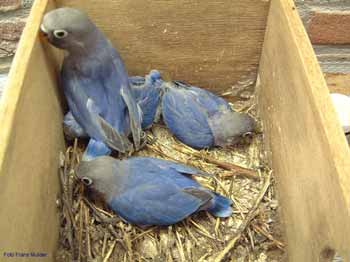|
AGAPORNIS W |
|
Starting to breed After having selected the place, the way of breeding (colony or single cages) and the birds, and done the treatment, we pass to the next phase that is the beginning of the actual breeding. If you are going to breed in single cages, you have to prepare the cages with a nest and material (palm branches) for the elaboration of it. After this process, introduce the birds. If you are going to breed in colony, distribute the nests all over the aviary, taking into account that you have to set them at the same height, and also two or three nests more than pairs you are going to introduce into the aviary, and put the material (palm branches) for its elaboration. After every pair select a nest, remove the remaining nests. This is a way to minimize fights for the possession of them. When the pairs feel safe in their new habitat, the building of the nest is done, that varies from 2 to 4 weeks, and the egg laying is done every other day. The incubation period varies from one species to another, and it is worth to mention that some hens begin the incubation after the second o third egg is laid. Sometimes this fact confuses non-expert breeders, who think that the eggs are not fertilized because the chicks do not birth after the stipulated days. Only with a simple mathematic operation is easy to know whether the hen begins the incubation after the third egg is laid, and if the stipulated time is 22 days, there will be a delay of 4 days in the birth of the chicks, taking into account the date of the first egg.
After the birth of the chicks, the hen is which feed them, receiving the food from the cock through regurgitation. After 2 or 3 weeks the task of feeding the chicks is a matter of the cock. When there are a lot of chicks the task is divided between the pair. The rings are usually put when the chicks are between 10-15 days old. Verify two or three days later that the rings are still in the bird’s leg, and pay attention to the parent’s behaviour, because sometimes the parents do not accept the rings and try to remove them from the chicks’ legs, injuring them. If this happens, cut the ring and be sure that the chicks of this pair could not be ringed ever. When the chicks start to leave the nest, it is better to leave them with the parents, since they need to learn to feed themselves and develop their defence instinct. If you breed in colony, pay attention to the chicks, because although the parents defend them, mainly the cock, other members of the colony can attack them. I breed in individual cages, and I remove the chicks when the hen is ready for the next incubation or when the birth of the new chicks takes place. Rarely the parents attack the chicks when they leave the nest, but if this happens the only solution is to separate the chicks from the parents.
In all the situations you can have doubts to decide the possible solution to adopt, choose the one which it seems for you less bad.
|
|
Copyright © 2003
Viveiro Curval. |








